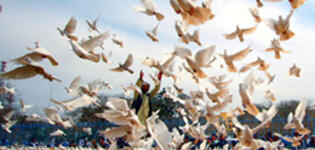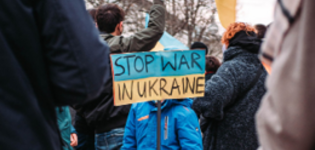Blog
How will the Russia-Ukraine war be fought?
External support and insurgency tactics
The Ukrainian state, personified by its President Volodymyr Zelenskyy, has been heroic and has surprised many by its 'stiff resistance'. However, Ukrainian cities are increasingly under siege and Russia is sending in reinforcements. Just days into the invasion, Russia is ramping up the bombing of strategic cities. In a scenario where Russia occupies Ukraine and the conflict is fought as an insurgency, the literature on external support — the often-covert provision of military support to rebels — can inform us on the future direction of the war.
Who will support a Ukrainian resistance?
In 2014, the West responded to Russia’s annexation of Crimea and military support to Eastern Ukraine with economic and political sanctions that many perceived as weak punishment for breaking international laws of non-interference and sovereignty. It has since become clear that weak punishment can backfire. Putin learned that Russian aggression in Ukraine would cause furore, but equally that Western states were not willing to pay the costs of imposing sanctions. Blame for the invasion in 2022 rests with Putin. However, it would be naïve to ignore how the West’s unwillingness to punish past aggression informed his decision.
If Russia occupies Ukraine or installs a vassal government, rival states will provide military support to the Ukrainian resistance. The risk of punishment and conflict escalation are higher for Russia’s rivals, especially in light of Putin’s thinly veiled threat of nuclear retaliation and subsequent move to put Russia’s deterrence on high alert. Western states are therefore likely to provide forms of support that are difficult to trace in order to mitigate the potential backlash of sponsoring the Ukrainian resistance: money and weapons.
External support in conflict is generally associated with longer conflicts as the number of potential ‘veto players’ increases, and this is especially the case when armed groups receive support in the form of money or guns. Furthermore, Ukraine shares long borders with four NATO states who will want to see a Russian occupation fail. The resistance will no doubt have access to foreign territory, which is detrimental for most counterinsurgency strategies and can prolong conflict.
What might the resistance look like?
External support may lead to relatively cohesive rebellions, especially when armed groups share external supporters. This was evident in eastern Ukraine where Russia had effective control over the armed actors in the Donetsk People’s Republic (DPR) and the Luhansk People’s Republic (LPR). There is also evidence that external states can manipulate, divide, or weaken a movement in order to promote their own, sometimes very different, political agendas. Unbridled support in the form of money and weapons can lead to competition and ultimately fragment the opposition. This happened in Syria, where the Free Syrian Army — recipient of military support from several, often competing, external states — collapsed into thousands of disparate rebel battalions under a banner that existed in name only.
The key factor for the Ukrainian insurgency will be the extent to which the provision of support is coordinated by external states. Coordinated external support can help foster a militarily effective Ukrainian resistance, as was the case during the Soviet-Afghan conflict when Pakistan and the US supported the Mujahedin. The West’s support to Ukraine, especially if provided by several NATO and EU states, will be highly coordinated.
International Crisis Group’s Olga Oliker noted that a Ukrainian insurgency is unlikely to resemble the Syrian conflict where rebel groups controlled large swathes of territory. Instead, she referred to the Provisional Irish Republican Army (IRA)’s fight against the British state from 1968 to 1998. The IRA received a staggering amount of Libyan military support in the 1980s. Mostly hidden in caches in the Republic of Ireland but used north of the border, the lethal support allowed it to pursue a long and constant war of attrition. The Ukrainian resistance, facing a much more powerful Russian military, may also adopt a transnational structure where military resources are stored in neighbouring states and smuggled into Ukraine to be used in asymmetric warfare against the Russian military. This is likely to result in a protracted conflict and brutal counterinsurgency.
This does not bode well for Russian efforts to occupy and ultimately pacify Ukraine. Ukraine could well be the beginning of the end for Putin. However, a successful insurgency is often a long one. Unless early peace negotiations are successful, Putin’s fall may take years and have unimaginable consequences for the Ukrainian People.
Kit Rickard is a PhD Candidate at the Political Science Department, University College London (UCL), and a Research Assistant at the Peace Research Institute of Oslo (PRIO). He is a co-author of an upcoming WIDER Working paper on the legacies of wartime order in Northern Ireland.
The views expressed in this piece are those of the author(s), and do not necessarily reflect the views of the Institute or the United Nations University, nor the programme/project donors.
 Join the network
Join the network
















